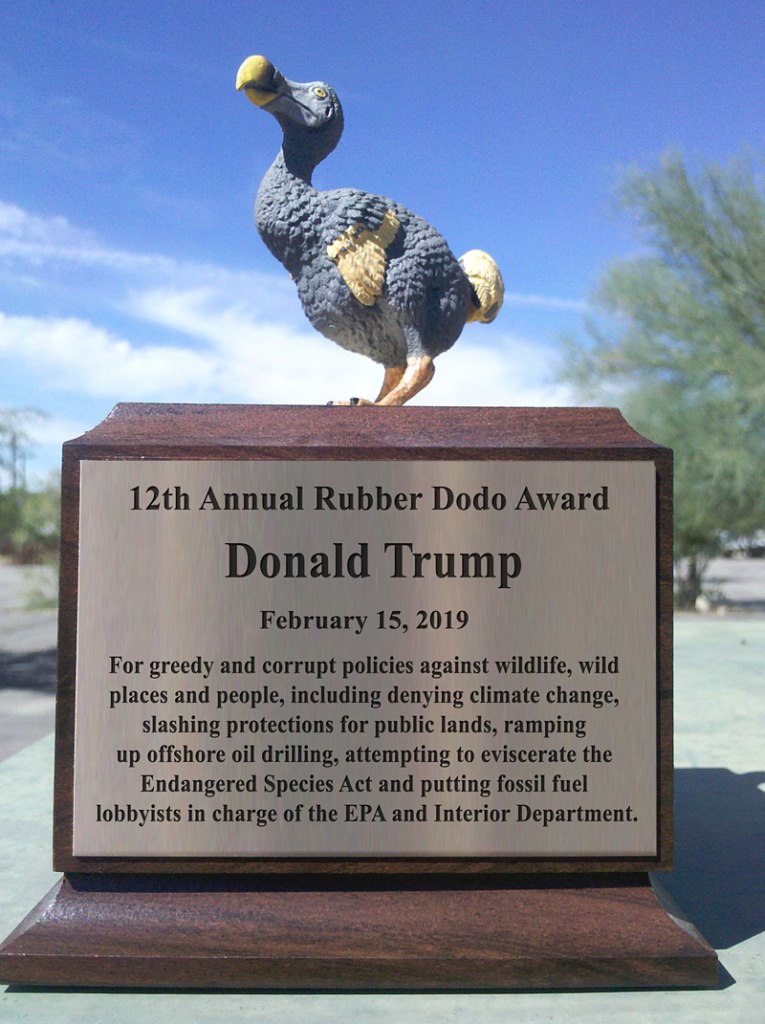Trump wins 2018 Rubber Dodo award as top eco-villain – “From wildlife to public lands to climate, Trump has wrecked, poisoned, and polluted our environment on an unprecedented scale”

TUCSON, Arizona, 15 February 2019 (CBD) – President Trump is the winner of the Center for Biological Diversity’s 2018 Rubber Dodo award. The statue is awarded each year to the person or group who has most aggressively sought to destroy America’s natural heritage or drive endangered species extinct.
“From wildlife to public lands to climate, Trump has wrecked, poisoned and polluted our environment on an unprecedented scale,” said Kierán Suckling, the Center’s executive director. “There’s never been a president with such a vicious approach to slashing protections for water, wildlife, lands and oceans.”
Among the Trump administration’s misdeeds: slashing protection for more than 2 million acres of Utah’s Bears Ears and Grand Staircase Escalante national monuments in Utah, opening Alaska’s National Petroleum Reserve for oil development, ramping up offshore oil drilling, denying climate change, putting an oil and gas lobbyist in charge of the Department of the Interior, putting a coal lobbyist in charge of the Environmental Protection Agency, attempting to eviscerate the Endangered Species Act and launching a plan to end protection for nearly every wolf in the lower 48 states.
“Trump’s greed and ignorance know no bounds, and it’s having a profound effect on the natural world,” Suckling said.
Trump won the Rubber Dodo award after an online contest where more than 12,000 people cast their votes. Other nominees were Wyoming Sen. John Barrasso, Interior Deputy Secretary David Bernhardt and Homeland Security Director Kirstjen Nielsen.
Previous Rubber Dodo award winners include Interior Secretary Ryan Zinke (2017), Rep. Rob Bishop (2016), Monsanto (2015), the U.S. Department of Agriculture’s Wildlife Services (2014), the Koch brothers (2013), climate denier Senator James Inhofe (2012), the U.S. Chamber of Commerce (2011), former BP CEO Tony Hayward (2010), massive land speculator Michael Winer (2009), Alaska Gov. Sarah Palin (2008) and Interior Secretary Dirk Kempthorne (2007).
Background on the Dodo
In 1598 Dutch sailors landing on the Indian Ocean island of Mauritius discovered a flightless, 3-foot-tall, extraordinarily friendly bird. Its original scientific name was Didus ineptus. (Contemporary scientists use the less defamatory Raphus cucullatus.) To the rest of the world, it’s the dodo — possibly the most famous extinct species on Earth after the dinosaurs. It evolved over millions of years with no natural predators and eventually lost the ability to fly, becoming a land-based consumer of fruits, nuts and berries. Having never known predators, it showed no fear of humans or the menagerie of animals accompanying them to Mauritius.
Its trusting nature led to its rapid extinction. By 1681 the dodo had vanished, hunted and outcompeted by humans, dogs, cats, rats, macaques and pigs. Humans logged its forest cover while pigs uprooted and ate much of the understory vegetation.
The origin of the name dodo is unclear. It likely came from the Dutch word dodoor, meaning “sluggard,” the Portuguese word doudo, meaning “fool” or “crazy,” or the Dutch word dodaars meaning “plump-arse” (that nation’s name for the little grebe).
The dodo’s reputation as a foolish, ungainly bird derives in part from its friendly naiveté and the very plump captives that were taken on tour across Europe. The animal’s reputation was cemented with the 1865 publication of Lewis Carroll’s Alice’s Adventures in Wonderland.
Based on skeleton reconstructions and the discovery of early drawings, scientists now believe that the dodo was a much sleeker animal than commonly portrayed. The rotund European exhibitions were likely produced by overfeeding captive birds.
Contact
- Kierán Suckling, (520) 275-5960